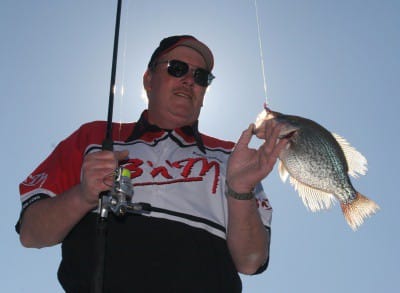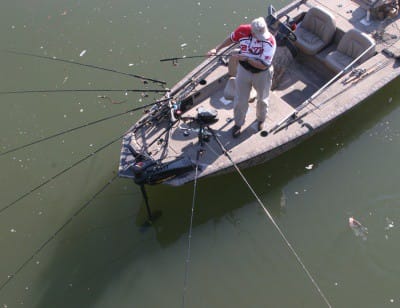
The first warm days of late winter and early spring mean one thing for many anglers. Time to catch crappie. These popular panfish are among the first fish to move shallow this time of year, and crappie are one of the easiest fish to catch.
Finding them, however, can be the hard part, says Kentucky tobacco farmer and crappie fanatic Steve Ferguson. Equally important, you have to know when to start looking. Go too early and those fish will still be hugging brush on deep ledges and flats.
“The males migrate to shallow water first,” he says. “That usually starts when the water gets into the high 50s or low 60s. Then the females, which tend to be larger, come in after the males.”
Ferguson fishes mostly on Kentucky Lake, a crappie factory that is loaded with the popular panfish. That doesn’t mean they’ll be scattered everywhere, however. Ferguson concentrates on pockets and coves away from the main lake, and he searches for shallow cover and flats within those areas. He says pre-spawn crappie tend to stage in areas adjacent to their preferred spawning sites. Typically, where you find sunken brush, stumps and laydowns close to spawning flats, you’ll find prespawn crappie.
“I’ll start toward the mouth of creek channels and flats in 12 to 18 feet of water and just start working my way shallower, but I’ll focus on brush and any other cover I can find,” he says.
When he’s fishing deep, Ferguson likes to spider-rig with as many as eight long rods at once. The term spider-rigging comes from the appearance of the boat and the rods extending from it. Some anglers use up to a dozen rods at a time, but Ferguson says that becomes unmanageable if the fish are biting.
“I like 14- to 16-foot B’n’M poles. The longer rods keep the baits away from the boat, which is real important if I’m working a shallow flat, say, anything less than 7 feet deep,” explains Ferguson. “Spider-rigging is the best way to cover a lot of water when the fish are deeper, too. With 14- and 16-foot poles, I can cover a path about 35 feet wide. I can set the bait on each rod to run at a different depth, but this time of year, they tend to be closer to the bottom.”

When he finds one fish, he’s confident he’s found a bunch. Crappie tend to stage in concentrated areas. On the contrary, if Ferguson worked his way through a cove or across a flat and failed to draw a single strike, he’ll move. Either the fish are there or they aren’t.
He also try working spawning cover like shallow brush, beaver lodges, laydowns and docks. If the timing is right and the fish aren’t in the staging areas, they just might be spawning. When Ferguson targets that shallow cover, he favors a jig or minnow under a slip bobber because it allows him to put the bait right in or next to the cover while keeping the bait in front of the fish. How deep he fishes the bait depends on the water depth. Crappie tend to stay close to the bottom when they spawn, so he’ll adjust the depth of the lure so it hovers a foot or two above the lake bed. In some cases, that might be 2 feet; in other lakes, that might be as much as 15 or even 18 feet below the surface.
“The clearer the water, the deeper they’ll spawn. I’ve caught them in Grenada Lake (Mississippi) in a foot of water. It’s a real muddy lake in the spring. I’ve also caught them in 18 feet of water on Barkley Lake (Kentucky) which is real clear that time of year,” explains Ferguson.
“I cover a lot of water until I start catching fish. I might run through a half-dozen spots if I’m not familiar with the lake. If they are there this time of year, they are going to eat your bait,” he says. “If they are actually spawning, they aren’t necessarily hitting your lure because they are hungry. Instead, they are more likely doing it out of defense. They guard their eggs just like a bass does.”
That’s why he doesn’t pay too much attention to his jig color. Ferguson tends to stick with a 1/16-oz. jig head tipped with a 1 1/2-inch Southern Pro crappie tube in either black and chartreuse or red and white.
“Everyone has their favorite color and they can all work,” he said. “What really matters is that you find the fish. Once you find them, catching them is the easy part.”



